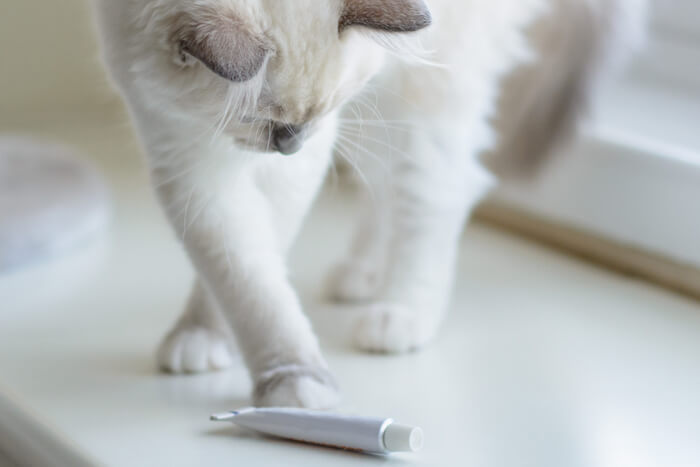
If you maintain a well-stocked medicine cabinet in your home, it probably contains a tube of Neosporin®. Given how often you may use this ointment on your own cuts and scrapes, you might find yourself tempted to also use Neosporin on your cat’s wound or abscess.
Neosporin for Cats Overview

However, there are unique risks associated with using Neosporin in cats, making this a poor option for feline wounds.
What Is Neosporin?
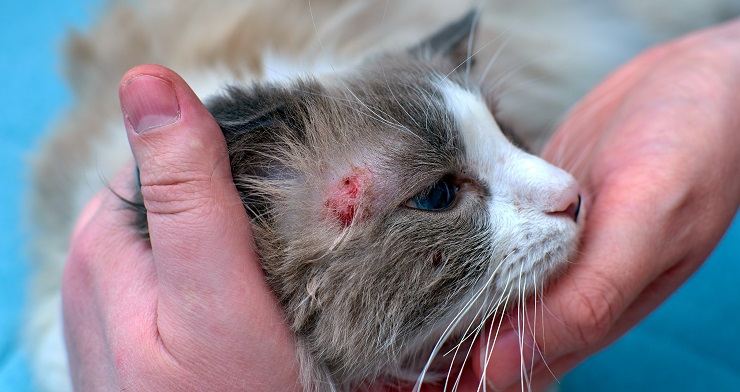
Neosporin is an over-the-counter antibiotic ointment that is commonly used to treat superficial wounds. Neosporin is often referred to as triple antibiotic ointment because it contains three separate antibiotics: neomycin, polymyxin B, and bacitracin. In some formulations, Neosporin also contains an additional drug for pain relief – pramoxine hydrogen chloride.
Neosporin is used to treat minor cuts, abrasions, puncture wounds, and other wounds. The antibiotics present in Neosporin help prevent bacterial infection and may even be effective at treating mild infections. In humans, these antibiotics are safe and well-tolerated, providing antibacterial benefits with a very low risk of side effects.
Is Neosporin Safe for Cats?
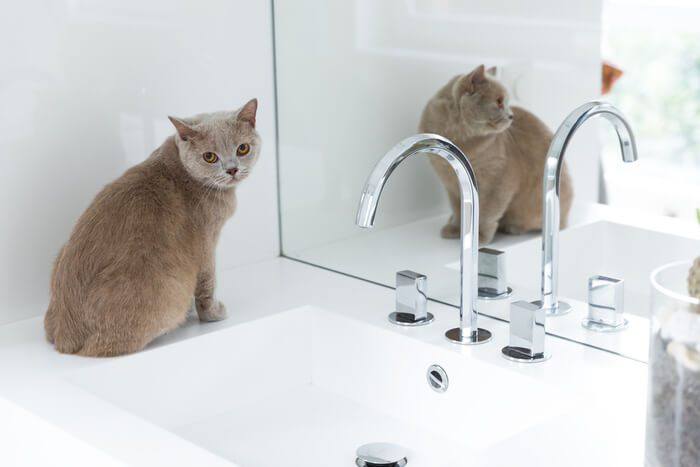
While Neosporin is safe for humans, it comes with some risks for cats. Cats groom themselves, meaning that they may ingest Neosporin applied to their skin and coat.
Cats do not tolerate Neosporin as well as their human owners. While there are certain scenarios in which cats receive Neosporin without any negative effects, serious side effects may occur in some cats that are treated with Neosporin.
When it remains on your cat’s skin, Neosporin is relatively safe. Some cats may have a mild allergic reaction to the ingredients, but these reactions are relatively uncommon with topical application. Neomycin and polymyxin B are more frequently associated with allergies than bacitracin.
Unfortunately, Neosporin rarely stays on the skin in cats.
Cats love to groom themselves, especially when they find a sticky ointment on their skin and in their coat. The same antibiotics that can cause a mild allergic skin reaction (neomycin and polymyxin B) can cause a much more severe allergic reaction when ingested.
While most cats that ingest Neosporin only experience mild gastrointestinal upset, a small percentage of cats can experience a significant allergic reaction. In some cats, this reaction can include anaphylactic shock and can even be fatal.
The risk of life-threatening reactions leads most veterinarians to recommend against the use of Neosporin in cats.
Effects of Neosporin on Cats
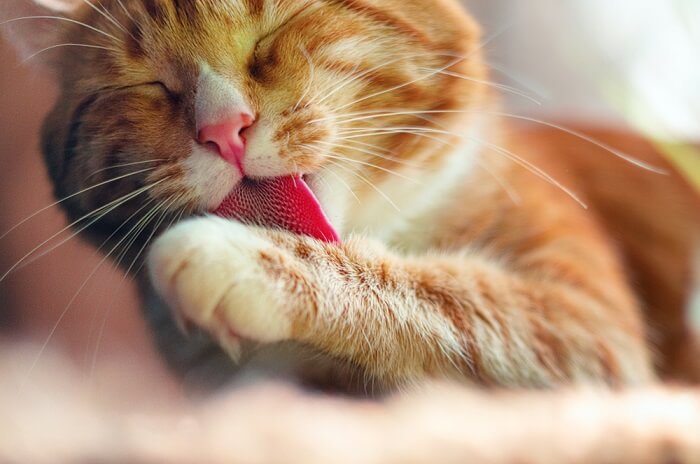
A cat that is experiencing a topical reaction to Neosporin will show signs of skin irritation, confined to the area where Neosporin was applied. The skin may become red, swollen, and itchy, causing excessive licking at the affected area.
If you see any of these signs develop, you should attempt to wash off any Neosporin that was applied to your cat, using a gentle pet shampoo.
Additionally, you should avoid using Neosporin on your cat in the future. If signs of an allergic reaction do not resolve with the removal of the medication, you may need to see your veterinarian for prescription medication to treat the allergic reaction.
If your cat has ingested Neosporin, you should monitor your cat closely. A brief episode of vomiting may occur, although this will usually resolve relatively quickly. If your cat experiences continued vomiting, diarrhea, or refusal to eat, contact your veterinarian for guidance.
You should also contact your veterinarian if you notice any other signs of a severe reaction, such as lethargy, weakness, or shortness of breath.
Alternatives to Neosporin for Cats
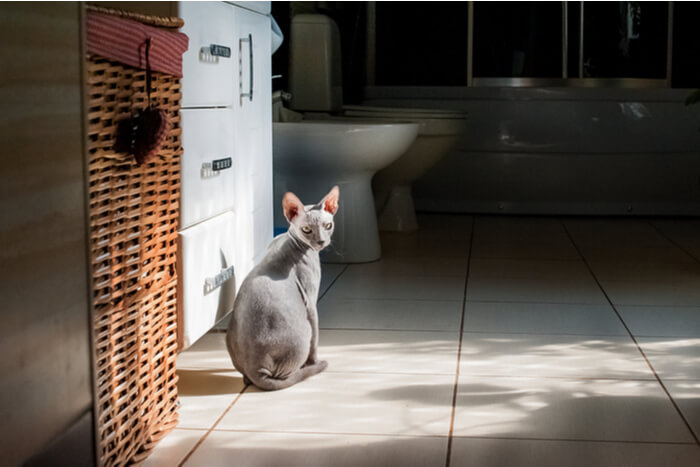
Instead of using Neosporin on minor scratches or other wounds, gently clean the area with mild soap and water.
Topical antibiotics can present a significant challenge in cats because cats are so fastidious in their grooming. Any topical ointment that you apply is likely to be licked off before it can offer much benefit.
Additionally, a cat that is trying to lick Neosporin or another ointment off his skin or coat may actually do more damage to the underlying wound than if the wound had simply been left untreated.
If your cat has a skin wound that you are concerned may become infected, the best option is to thoroughly clean the wound with mild soap and water.
If the wound becomes infected despite this basic first aid, skip the Neosporin and schedule an appointment with your veterinarian. Your veterinarian can prescribe oral antibiotics that will be far more effective at treating a wound infection than a topical ointment.
Conclusion

Although Neosporin is very safe for use in humans, it can present significant health risks when used in cats. While you may hear reports of cat owners who have used this medication in their cats without incident, life-threatening problems can occur. Given that cats tend to lick this medication off soon after it’s applied, the benefits of Neosporin do not outweigh the risks.
Frequently Asked Questions
What antibiotic ointment is safe for cats?
Unlike dogs, cats can have life-threatening allergic reactions to antibiotics that are commonly included in topical antibiotic ointments. For this reason, it’s best to avoid antibiotic ointments in cats and seek veterinary care for infected wounds.
What can I put on my cat's wound?
If your cat develops a new skin wound, clean the wound thoroughly using a mild soap and water. Avoid putting topical ointment on the wound, because these ointments often encourage cats to lick at the wound and cause further problems with healing. Instead, clean and monitor the wound, seeking veterinary care if you notice signs of infection.
Can you use Neosporin on a cat?
Neosporin is not recommended for use in cats. While most cats can tolerate topical Neosporin relatively well, some cats may experience a life-threatening allergic reaction.


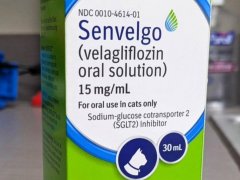





Everyone in the 70’s 80’s and 90’s used neosporin on the cuts and scrapes of their animals with great success. Why now is it dangerous?
Hello, I applied neosporin onto my arm, but I picked up my cat and realized that where she hangs on my arm was ontop of the cut I applied the Neosporin to. Upon realizing this, I grabbed a grooming comb that uses a mist to help remove fur for a few minutes. Will she be okay? I’m worried. Thank you.
It sounds like you did the right thing, Manny. Keep monitoring your cat and contact your vet if you notice any changes in behavior or other side effects.
My kitty was licking and scratching to the point of having some bare patches of skin. She’s treated for fleas and other things, so that wasn’t the problem. Thought maybe alergies, so took her to the vet. The vet gave her steroids, and it worked. She also had a serious kidney infection that she’d been given antibiotics for, but didn’t help. Vet said her PH level was too high, leading to crystals in her urine. Switched her to food to correct this, and spring water instead of well water, and the affect was almost instantanious! It was exactly what she needed, and she is healthier than she’s ever been. Thankful for a good vet who identified the problem instead of just keeping her coming in for more antibiotics.
My cat is missing a patch of hair I gave it newsprint help
Hi Eva, thank you for reaching out! I’m not sure I fully understand what’s going on here. A missing patch of hair may be caused by a variety of things, including overgrooming and stress. I would recommend talking with your vet to figure out what’s going on.
If my cat has ingested neosporin, how long after this happened would I see a reaction?
Hello Pam, if your cat has an allergic reaction to the ingredients of Neosporin, it will usually take between 5-30 minutes for symptoms to appear.
Don’t use antibiotic on animal wound, the best it Ozonol, an antiseptic and it is cheap. I have been using it and they don’t lick it off cuz it is yukky.
Hi Louise, I would not recommend this. Ozonol contains zinc oxide, which can cause GI issues in cats when ingested, and it may destroy red blood cells as well. Not a good choice for pets.
I meant medicate her, not Medicare her (error) also I have a rescue cat , not gave
Thanks for the corrections! I understood your comment as-is, but this helps, too. 🙂
This female cat I have (calico) spayed, rescue from shelter 1 1/2
Years ago, over grooms to the point of having patches of hair missing on back, flanks. If she’s not sleeping, or eating, excellent human grade food, (open farm) very expensive,, then she’s biting, chewing, pulling out her hair, knocking over her water dish. This is so stressful on me and cat, I am at my ends wit. Has been to vet 3 times, treated for skin infection. Yet continues this Behaviour. Iam involved in animal rescue, have been for years, have had so many pets. Never have I been through this. I’m in a wheel- chair, retired from medicine, this is so stressful. Cannot pick her up, or hold her, to put flea meds on her.??????,,
I’m not a vet or behaviorist, but it sounds like your cat may have some kind of stress issue. You say that you can’t pick her up—does this mean that she seems to be afraid of you? If she is still nervous about you touching her, there is a chance that she is, for some reason, stressed by human contact and perhaps the home environment in general. This kind of overgrooming is also indicative of a stress problem. I would recommend treating her as if she does suffer from stress. Feliway (synthetic feline pheromones) may help, as could environmental enrichment with scratchers, places to climb, and hiding places. The other thing I’d think about is the potential for this being an allergic reaction. Environmental allergens are sometimes an issue, but you may also find that your cat is allergic to one or more of the proteins in her diet. Is she eating a limited-ingredient diet from Open Farm? I would advise gradually switching to a limited-ingredient, single-protein food that doesn’t contain any of her most common protein sources. Done correctly, this would serve as an elimination diet and help you to determine if there is a dietary issue at the bottom of this.
Hope you can get this resolved soon!
All the best to you and your cat,
Mallory
This lady needs help with her cat not English smh
I gave a rescue female spayed calico cat about 7!yrs old., sweet , sleeps with me, I can pet her, yet I cannot pick her up or Medicare her. She overgrooming to the point of missing fur and small scabs on her flanks. No fleas or parasites, exc., diet. What can I put on her scabs, I’m concerned. Been to vet twice.im on a fixed income, not a lot of $$$$ for vet visits .
Hello Sheila, thanks for commenting! Sorry to hear that your cat has been overgrooming like this. Unfortunately, I am not a vet and can’t give medical advice. My best suggestion would be to try to identify the underlying cause of this overgrooming and resolve it. Anti-inflammatory supplements like omega-3s from fish oil may also help. This article has a number of suggestions for treating the raw skin: https://canna-pet.com/cat-skin-conditions-natural-remedies/
I am not a vet, but I use a small amount of honey instead of antibiotic ointments for minor skin wounds on my cats. Honey is antibacterial, and I have not seen any info rmation suggesting it is toxic. It works if you need something quick. And, of course, consult your veterinarian for anything more.